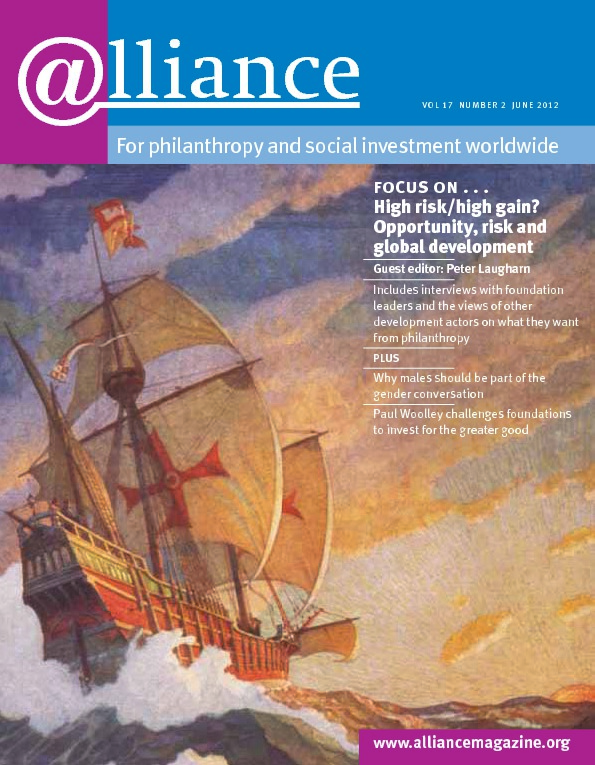The cover of this issue of Alliance shows Christopher Columbus’s ship – presumably on its way to discovering the ‘New World’. The explorer’s fragile ship, buffeted and tossed by huge waves, on an expedition that turned out to have momentous results but could well have ended in the loss of the ship and all aboard it, provides an apt analogy for the sort of ‘high risk/high gain’ activity that the special feature in this issue of Alliance encourages foundations and philanthropists to embrace. While risky philanthropic ventures do not involve personal risk in the way that the early voyages of exploration did, they can involve great ambition, unknown outcomes, and the danger of failing totally – though not dying in the process.
The image of Columbus is an ambiguous one. Discovery of the Americas did result in tremendous advances for western society, but the Native peoples of the colonized lands were aggressively wiped out and made invisible. Does this ambiguous image fit philanthropy?
The first issue raised by Columbus is unintended consequences. If philanthropy takes on the biggest challenges, there may well be unintended consequences. But will it be accountable and committed to correcting its mistakes? When foundations fund the creation of parks and protected areas in the process of which Indigenous Peoples are evicted, or when Native healers and farmers are displaced by the expansion of western medicine or agriculture, who is accountable? How often are foundations ready to compensate for the unintended consequences?
Another issue raised by the Columbus icon is imperialism. Like Columbus, foundations often seem to impose their values and culture on those they are supposed to benefit. They too easily interpret ability to fill out their application forms, follow their reporting guidelines and track their indicators as ‘capacity’, when they really mirror their own culture and worldview. Significantly, philanthropic funding to Indigenous Peoples is usually given through intermediaries on the grounds of their lack of capacity.
Obsessed with strategic focus, a foundation may perceive as good grantees those that can best implement its chosen strategy, showing little interest in grantees’ culture or goals, or in their knowledge and vision. This approach can have harmful consequences. ‘Narrowly targeted interventions that ignore local insight and capacity can do lasting damage to the ability of communities to develop their own sustainable solutions,’ warns James Mwangi.
As the good ship philanthropy embarks on its global mission, it could do well both to embrace the ambition and daring of Columbus and to beware the rocks on the way.
Caroline Hartnell Editor, Alliance
Rebecca Adamson Founder and president, First Peoples Worldwide
This article from our guest editor is the first of a number focusing on the topic of opportunity, risk and global development.The full special feature is available to read online for subscribers to Alliance magazine. If you do not yet have a subscription, discover more about the options available.






Comments (0)